Japan's Official Development Assistance White Paper 2012
Section 3 Various Aspects of Growth through Human Resource Development
Economic growth is not the only type of growth stimulated by aid. Growth in terms of capacity through human resource development helps to cultivate the workforce needed for nation-building. In order for developing countries to grow and support themselves, it is necessary for them to develop and secure good enough human resources who are responsible for their future development. Assistance for human resource development using Japan's ODA has been provided in many regions around the world. This assistance has been conducted in the various areas required for forming the foundations of nation-building such as agriculture, health/medical care, education and vocational training. It has contributed greatly in strengthening the confidence that other countries place in Japan.
Human resource development cooperation is conducted in an environment of person-to-person communication. In addition to the capacity-building aspects, this type of assistance is also useful in deepening mutual understanding and friendships through its personal interaction.
The following section will introduce a few examples of human resource development assistance by describing specific projects. The first part describes projects in the education area that began in Kenya and spread throughout Africa.
●Strengthening of Mathematics and Science Education in Western, Eastern, Central and Southern Africa (SMASE-WECSA)
In Africa, there is a pressing need to develop human resources who possess the scientific knowledge and skills needed for industrial growth. However, children's academic ability in mathematics and science is low, and the lack of teaching capabilities of teachers is a large issue. For 10 years beginning in 1998, Japan cooperated with the Kenyan Ministry of Education to implement the Project on Strengthening of Mathematics and Science in Secondary Education, for which training was provided for approximately 20,000 secondary education teachers of mathematics and science in Kenya. As an outcome of the 15-year project, the one-sided, teacher-centered teaching style that did not consider students' learning process was transformed into classes where students can actively and willingly participate. This was achieved by encouraging teachers' initiative and inventive approaches. As a result, students have shown increased motivation to learn and the number of students selecting science-related subjects has risen. Subsequently, it was requested that the efforts started in Kenya be spread to other African countries facing similar issues and in 2001, the Strengthening of Mathematics and Science Education in Western, Eastern, Central and Southern Africa (SMASE-WECSA) was established. Through SMASE-WECSA*, Kenya has provided training and technical assistance for building a training system for teachers of mathematics and science in other African countries. From 2003 to 2012, there have been approximately 1,500 people from 30 countries who have participated in the training in Kenya. It is anticipated that these trainees then return to their respective countries and conduct training for many mathematics and science teachers there.
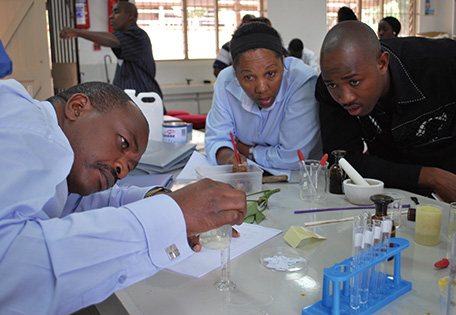
Teachers from various African countries receiving training. These participants will then return to their respective countries to provide training for other teachers in their home countries. (Photo: JICA)
Human resource development is not limited to schools. In Uzbekistan, the Japan Center* was established to highlight Japan's ODA activities and to act as a hub for developing a human network between Uzbekistan and Japan. Here, human resource development for business people is being conducted.
●Uzbekistan-Japan Center for Human Development
Uzbekistan gained independence from the former Soviet Union in 1991, upon which it began to transition from a socialist economy to a market economy. However, economic reforms did not progress smoothly. In 2000, Japan established the Uzbekistan-Japan Center for Human Development with the purpose of training the human resources that will lead the transformation of Uzbekistan's market economy and to promote mutual understanding between Japan and Uzbekistan. At the Center, personnel are trained through a business course for young business people. In this course, Japanese business practices are taught, some of which include "5S" (standing for Sort, Straighten, Shine, Standardize, and Sustain, a methodology used in the Japanese manufacturing and service industries for continued improvement of the workplace environment) and "Kaizen" (used mainly by workers on production floors in the Japanese manufacturing industry, this method involving the continuous review and improvement of work practices with the goal of increasing quality). Approximately 5,400 people have completed this course thus far (as of July 2012) and more than half of course graduates are heads of small and medium enterprises (SMEs) or middle managers. The opportunity to learn practical business skills in this course has been received favorably, making it so popular that the acceptance rate into the course is 1 to every 2~3 people. Additionally, a completion certificate will not be issued if students do not maintain a constant level of performance and attendance for the course, which is another reason for its good reputation. Currently, assistance is being provided for training local instructors as the Japan Center prepares to become self-reliant. In February 2012, a training session was held in Japan for 19 local teachers from 3 countries in conjunction with the Japan Centers of neighboring Kazakhstan and the Kyrgyz Republic. In this training session, participants visited Japanese manufacturers (electronics, pharmaceutical), as well as various companies in areas such as trading, food service, distribution, and retailing. They studied practical cases within Japanese companies regarding human resource management, business strategy, and marketing methods. By including many actual examples of Japanese management style, it is expected that the training session will be invaluable for use in courses at the Japan Center.
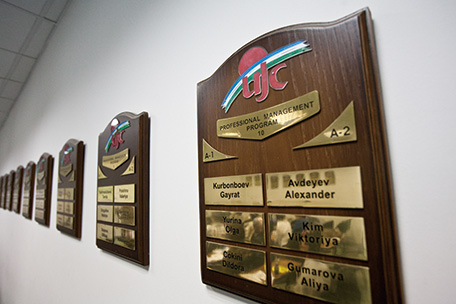
Uzbekistan-Japan Center for Human Development (Photo: JICA)
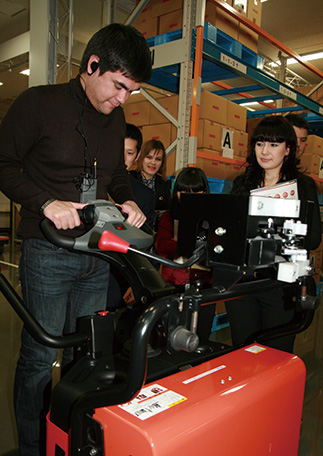
Top students of the courses at the Uzbekistan-Japan Center tours a Japanese company in Chiba Prefecture. (Photo: JICA)
A project that makes use of Japan's strengths in science and technology is the ASEAN University Network / Southeast Asia Engineering Education Development Network outlined below. It aims to nurture teaching personnel through academic cooperation throughout the entire region and to create a joint research network.
●ASEAN University Network / Southeast Asia Engineering Education Development Network
To summarize the ASEAN University Network / Southeast Asia Engineering Education Development Network (AUN/SEED-Net), it is a consortium consisting of 19 institutions from 10 ASEAN countries (Note 2) and 11 universities from Japan that jointly aim to improve the qualifications of teaching personnel in the engineering field and strengthen the networks among the universities. Working towards this goal, 400 professors from the ASEAN side and 200 from the Japan side are involved in creating a human network.
The catalyst for beginning AUN/SEED-Net was the 1997 Asian financial crisis that began in Thailand and gripped many ASEAN nations. In the background of the financial crisis the fragility of industry was pointed out, and the need to increase both the quality and quantity of industrial human resources was recognized. Japan, which has the most companies expanding into ASEAN countries, thus decided to provide assistance in developing these industrial human resources, and subsequently concluded an agreement with the 10 ASEAN countries.
Excellent teaching staff is crucial to developing excellent industrial human resources. Without high-quality teachers, good human resources are not nurtured. In order to increase the quality of university teaching staff, providing assistance for overseas study to allow them to acquire master's degrees and doctoral degrees is one aim of the project. Thus far, there have been a total of 796 people (masters: 496, doctorate: 300 as of February 2012) who have been given the opportunity to obtain a master’s degree or doctorate through this program. The majority of these teachers obtaining degrees have returned to and continued to teach at the universities where they had been employed.
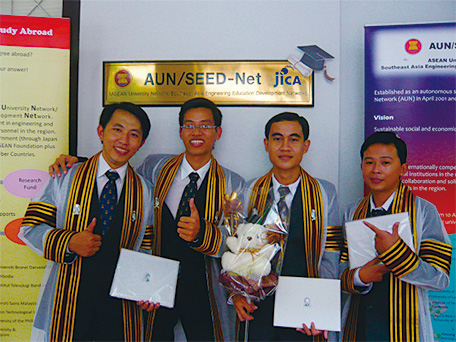
Young teachers who received their degrees at Chulalongkorn University in Thailand. (Photo: JICA)
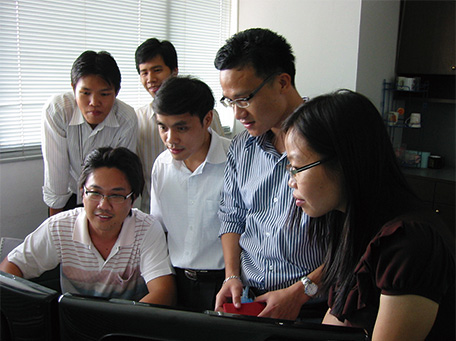
ASEAN students learning together at AUN/SEED-Net. (Photo: JICA)
- *Strengthening of Mathematics and Science Education in Western, Eastern, Central and Southern Africa (SMASE-WECSA)
- This network was established with the purpose of promoting mathematics and science education in Africa, as well as encouraging collaborative efforts within the region. For this, the improvements made in mathematics and science education through in-service training for teachers in Kenya are shared with other African countries. The network was formed at the first SMASE-WECSA Conference held in Kenya in 2001, with educators from various countries participating (mainly Ministries of Education). There are currently 27 member countries as of the end of 2012. In cooperation with the Kenya Ministry of Education, assistance has been provided for implementing training programs in Kenya for member countries (third country training), as well as technical assistance and experience-sharing workshops.
- *Japan Center
- These facilities were conceived in 1998 as a way to highlight Japan's ODA activities in countries with transitioning economies and to serve as a base for developing human resources and forming human networks between the host countries and Japan. They began to open in succession beginning in 2000. Located primarily in Southeast and Central Asia, 9 centers have been established in 8 countries (Viet Nam (Hanoi, Ho Chi Minh), Laos, Cambodia, Mongolia, Uzbekistan, Kazakhstan, the Kyrgyz Republic, and Ukraine). Their main programs include business courses, Japanese language courses, and programs to promote mutual understanding.
Note 2: ASEAN countries: Brunei, Cambodia, Indonesia, Laos, Malaysia, Myanmar, Philippines, Singapore, Thailand, and Viet Nam
